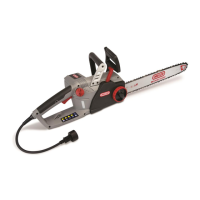A
4
CS1500 CHAINSAW TOOL TIPS
What’s in the Box?
These items ship with the chainsaw:
1) Operator’s Manual
2) Chainsaw Powerhead
3) Saw Chain
4) Guide Bar
5) Chain Tensioning Gear,
O-ring and Screw
6) Blade Cover
After removing the chainsaw from the box,
inspect it carefully to ensure no damage has
occurred during shipping and that no parts are
missing. If any parts are damaged or missing,
do not use the chainsaw. Contact Oregon
®
to
obtain replacement parts. For country-specic
telephone numbers, see “Customer Service by
Country”.
CAUTION: Bar and chain oil
prevents premature wear. Never
operate the chainsaw if oil is not
visible. Check oil level frequently
and fill as needed.
3
BLACK
A
ASSEMBLING THE GUIDE BAR
AND SAW CHAIN
STEP 3: Fully loosen the side cover
release knob (A) and remove the side
cover.
5
STEP 5: Attaching the tensioner to the
guide bar. Insert and properly tighten
the screw from the back side of the
chain tensioning gear to attach it onto
the guide bar.
CAUTION: There is a black washer
(A) that is important to the function
of the saw. The black washer must
be in place around the pin on the
tensioner before the tensioner is
screwed onto the bar.
2
3
4
5
6
CAUTION: SAFETY NOTICE.
Unplug the chainsaw.
FILLING THE BAR AND
CHAIN OIL RESERVOIR
STEP 1: Place the chainsaw on a firm,
flat surface, so that the oil cap (A) is
on top.
• Clean any debris from the cap area.
• Remove the cap.
• Carefully pour 120 ml of bar and
chain oil into the reservoir.
Plug in the chainsaw.
If the reservoir is totally full on
initial startup, it can slow down
the prime. We suggest 90% full.
STEP 2: Run the saw for around 2
minutes or until you see oil present on
the bar pad.
When the oil system has been primed
as per the above steps, unplug the
chainsaw.
Remember to top up your bar and chain
oil regularly.
2
1
A
1
IMPORTANT: SAFETY NOTICE. Chainsaw chain is sharp.
Wear protective gloves when handling chainsaw chain.
WARNING: An electric power tool that is plugged in can start
accidentally. Unplug the chainsaw before preparing for use or
performing maintenance.
WARNING: For Safe Tool Use and to Avoid Common Mistakes, read the entire Operator’s Manual paying particular attention to
Safety Instructions and Warning Icons. These Tool Tips are intended to be a supplement, not a replacement for your Operator’s Manual.

